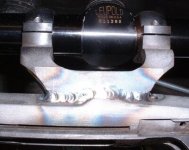For quite a few pistols, I have measured the minimum amount of powder
necessary to get a semi auto to cycle with the stock spring and also the
amount of powder with the heaviest spring available. What I have found
is that only a fraction of the momentum of the bullet is reflected in
the momentum of the slide and barrel. It seems that most of the recoil
is transferred to the hand before the bullet leaves the barrel.
http://www.m1911.org/
click on the pistol
click on technical issues
click on recoil spring selection tips by Bill Wilson
"As a rule of thumb, you should use the heaviest recoil spring possible,
which does not interfere with the pistol functioning."
I use AA#5 as you can see it has a very predictable powder to pressure
ratio
1) 45 acp 185 gr 1100 fps 10.2 gr AA#5 18,000 psi
2) 45 acp +P 1200 fps 10.8 gr AA#5 21,700 psi
3) 45 Super 1312 fps 12.4 gr AA#5 28,000 cup
4) 460 Rowland 1500 fps 14.5 gr AA#5 38,800 cup
Example:
Patriot 45acp
http://www.republicarmsinc.com/
15 pound to start and 42 pound spring at the rear [home made spring
assembly], is just right for 10.3 gr of AA#5. That is, it is just enough
powder to keep the Patriot from jamming with that spring.
The bullet leaves the gun at 1100 fps.
The bullet weighs 185gr = 185/7000 = .026 Lb.
The slide weighs .5 Lb.
The barrel weighs .1 Lb.
The spring is 15 Lb to start.
The spring is 42 lb at back.
The momentum of the bullet equals the momentum of the slide and barrel.
[1100][.026]=V[.5+.1}
V=47.7 feet per sec
Velocity of slide and barrel = velocity of slide
Energy of slide = .5mVV= one half mass velocity squared
Es=.5[mass of .5 pounds][47.7][47.7]
Mass = [wieght]/gravity= .5/32.2=.0155
Es=.5[.0155][47.7][47.7]=17.64 foot pounds of energy
The energy required to pull back the slide = [force][ distance]
Force = average force = [15+42]/2 = 28.5 pounds force
distance = 1.656"=1.656/12=.138 feet of slide stroke
Eslide = [28.5][.138]=3.93 foot pounds
BUT WAIT A MINUTE! 17.64 DOES NOT EQUAL 3.93!
Not all of the bullet momentum went into the slide and barrel.
Some of it accelerated the hand.
Only 3.933/17.64= 22% went into the slide and barrel.
What does this mean to someone who wants to calculate the spring needed
for a semi auto pistol?
Heavy firm hands need stiffer springs than soft light hands and there is
no good way to measure how light and soft one's hand is.
So, you cannot accurately calculate the spring you need.
However, a CZ52 9mm pistol takes 4.7 gr AA#5 to cycle with a 125 gr .357
bullet. Put in a Wolff +10% spring and it takes 5.3 gr AA#5 to cycle. So
you can calculate spring requirements over a small region of already
known spring requirements.
The 22% finagle factor [above] will go up for heavier slides with
lighter springs. The above example is an extreme case of light slide and
heavy spring. The numbers are usually around 30~33%.
Never say "limp wristing" again. Say, "If the gun jams, get a lighter
spring. If the slide slams the frame, get a heavier spring."
Clark





